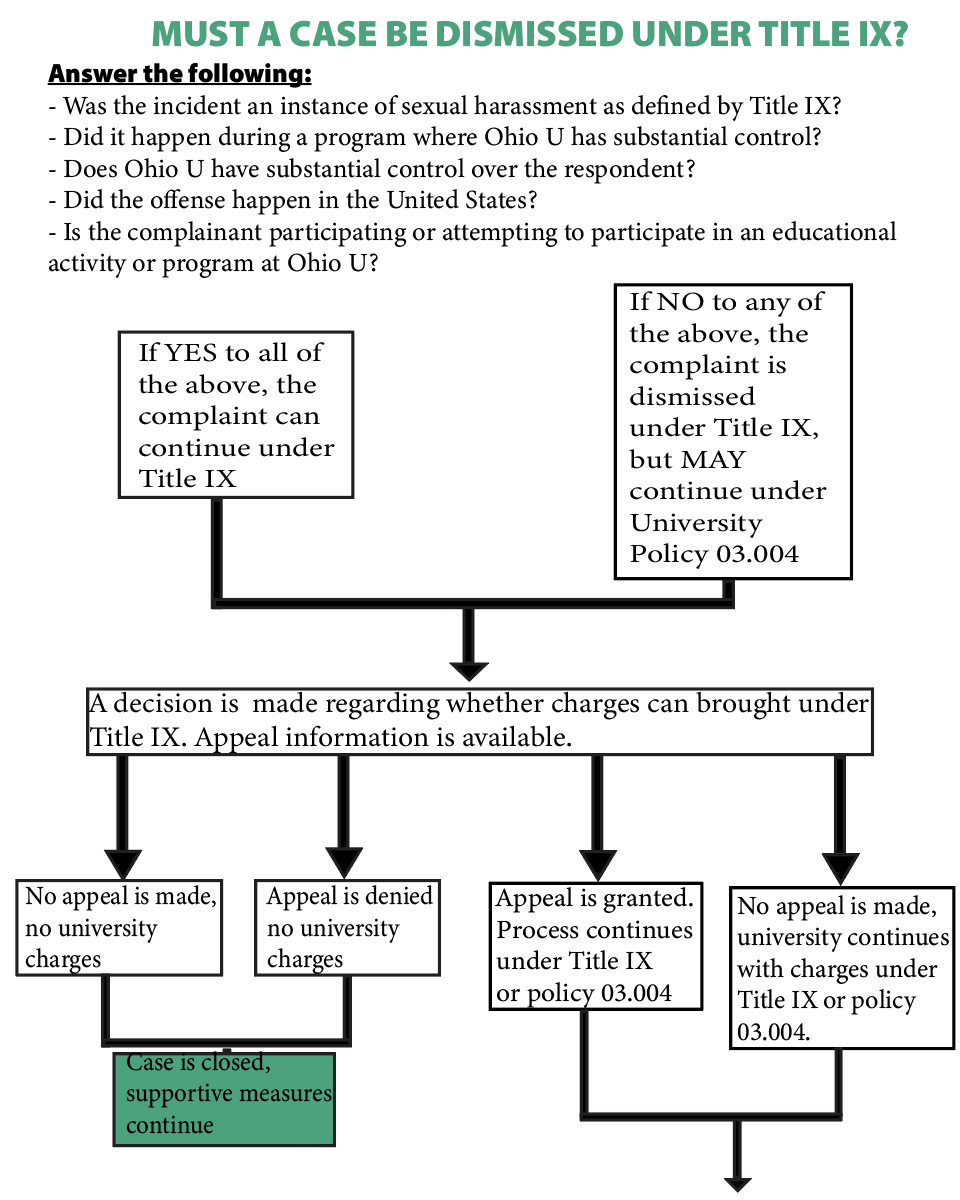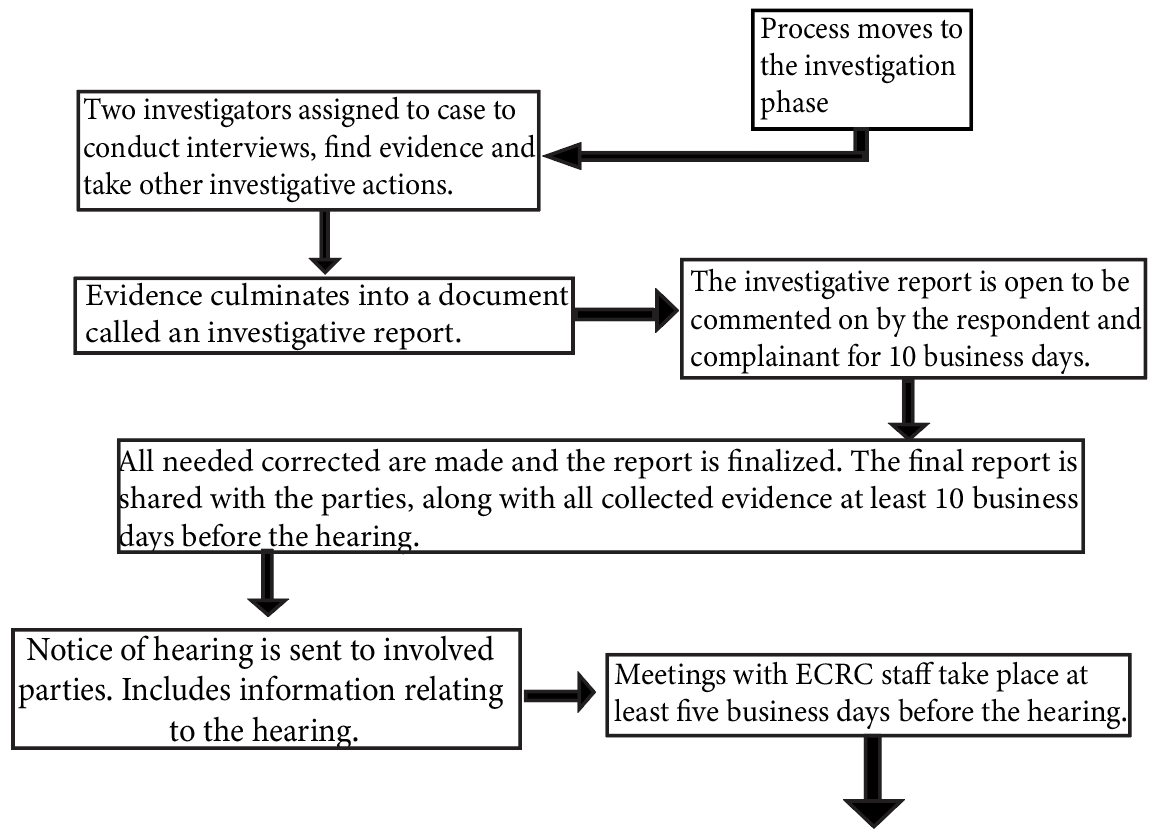Mock trial: Navigating the Title IX grievance process
Editors Note: This story is part of a collaboration with Ohio State University’s The Lantern. Student Perceptions of Sexual Violence, a look at the state of sexual violence prevalence, education and reporting on our respective campuses.
Editor’s Note: This article was updated to specify language used during the Title IX process, noting the difference of days and business days and the difference of a hearing and a trial. The ECRC fax number was updated, as well. The flowchart was also amended to reflect these changes.
After experiencing an incident of sexual misconduct, it is not uncommon for survivors to feel depressed, alone, out of control or anxious.
At Ohio University, there are resources available to aid survivors.
The Ohio University Office of Equity and Civil Rights Compliance (ECRC) is charged with handling misconduct reports as well as assisting those who have experienced sexual violence. The ECRC is also responsible for handling the grievance process.
Pre-investigation
Flowchart by Izzy Keller
There are many ways to make a report to the ECRC. There is a reporting form on the ECRC website, and those interested can walk in and report at the ECRC Office in 006 Lindley Hall, call the ECRC at 740-593-9140, fax a report to 740-593-9168 or email titleix@ohio.edu.
Reports can also be filed with the police. The ECRC must file police reports that could potentially contain a felony, per Ohio law.
“If we receive it (a report) and it does have enough information, and it seems it could be a felony, then we contact law enforcement in the appropriate jurisdiction, OU, APD (and) I've called jurisdictions across the state to make that report,” Deputy Title IX Coordinator Karen Petko said in a Microsoft Teams interview.
Upon receiving a report, ECRC staff, often Petko herself, will reach out to survivors through a confidential letter system. According to Petko, this past academic year the ECRC has reached out 225 times to 119 people.
“How many attempts depends on the nature (of the situation). If it's a situation where somebody mentioned in an assignment for a class, very quickly mentioned that something happened when they were a child, I reach out with resources,” Petko said. “But I don't tend to kind of (be) persistent with that too far if they've opened their letter because we can see if they've opened a letter. But if it's something active, I make multiple attempts to try to make sure that they know that we're here and have the information.”
Anybody can make a report to the ECRC. Ohio U employees, including faculty and student employees, are mandatory reporters, meaning they must report instances of sexual misconduct to the ECRC.
Reports can be about any instance of sexual violence or misconduct. The ECRC can provide assistance for sexual misconduct that happened at any time, from childhood abuse to recent instances of misconduct.
According to a survey conducted by The New Political and The Lantern, only 20% of respondents who had experienced sexual violence reported it. The survey also showed only 33.3% of those who reported incidents of sexual violence reported to their university’s Title IX office.
Petko believes these low numbers are due to misconceptions about their office, as well as individuals wishing to deal with misconduct on their own terms.
“The way they (a survivor may) need to process and address a situation is through seeking help –– is through pursuing an investigation. That's what they need. But for other people, they need their space. They need to deal with it in another way. And, you know, there's some misconception, that we work hard to try to dispel, that if they talk with us, it has to be about an investigation, (which) is absolutely not true,” Petko said.
Once contact has been made, the ECRC sets up an intake meeting. In the meeting, the person who experienced misconduct is taken through the grievance process, if they so choose, and offered supportive services.
“The content of that meeting depends upon what they need. And so there's at least two parts to it. And one is talking to them about their needs and what supportive measures they need from us,” Petko said. “And the other part is providing them information about the process and what that looks like.”
Supportive measures at Ohio U include: referrals to counseling, no contact orders, academic support, schedule modifications, increased monitoring of campus areas, changing housing assignments and any other measure that could potentially help a person reporting.
One of the most vital resources for survivors at Ohio University, according to Petko, is the Survivor Advocacy Program (SAP). SAP is a confidential resource, meaning they are not obligated to report sexual misconduct to the ECRC. To learn more about SAP, head to https://www.ohio.edu/survivor.
“My number one recommendation to every person I talk to is that they contact SAP. It is entirely their choice, but it is the best resource we have on this campus for these folks,” Petko said. “I am a huge fan of every single person that works there. And they can help them process it outside of a meeting, in a different setting with a different relationship. And so they're incredibly helpful.”
If the person who experiences misconduct chooses, they can partake in the Sexual Harassment and Other Sexual Misconduct Grievance Process. This process exists due to Title IX of the Higher Education Act.
Title IX promotes “equal access to education for all students and it prevents them against discrimination on the basis of sex,” according to the Department of Education’s Title IX website.
The grievance process can be a lengthy and complicated process. According to a digital guide put out by the ECRC detailing the process, it is supposed to take about 90 business days and follows the Title IX changes, known as the final rule, put forth in May 2020.
If a victim so chooses, they can sign a formal complaint and begin the grievance process. A formal complaint is not the same as making a report to the ECRC. If someone makes a simple report to the ECRC, that does not start an investigation.
“For me, the most important thing is that a survivor of sexual misconduct understands that she or he drives this bus,” Ohio U Title IX Coordinator Kerri Griffin said in a Microsoft Teams interview. “And because people need that kind of agency to say ‘this thing happened to me, and I need to figure out how I want to deal with that. Maybe I want your help, maybe I don’t.’ And our job is to support them in that.”
Flowchart by Izzy Keller
If a party opts not to file a formal complaint, supportive measures continue and the process typically ends. At any point, a person can decide to sign a formal complaint, even after initially refusing. Although extremely rare, the Title IX Coordinator can choose to sign a formal complaint without a complainant.
At any point during the process, a formal complaint can be dismissed under Title IX. However, this does not mean that nothing can be done. The process can still continue through Ohio University Policy 03.004. Previous reporting by The New Political discussed changes to Title IX in 2020, as well as the sexual misconduct grievance process in detail.
There is no notable difference between University Policy 03.004 and Title IX. Both follow the same grievance process and carry the same weight.
Investigation
Flowchart by Izzy Keller
After a formal complaint is filed, a notice of investigation and allegations is sent to the respondent. This allows the respondent, the party alleged to have committed sexual misconduct, to know there is an investigation into their conduct. After receiving a notice of investigation and allegations, the respondent has a meeting with the ECRC.
Following this meeting, the ECRC begins investigating. According to the ECRC, the investigation should take about 40 business days. All pertinent evidence gathered during this period culminates into an investigative report to be shared at a hearing.
A draft of the investigative report is sent to the complainant and the respondent near the end of the investigation. For 10 business days, both parties can offer edits to the report. After receiving comments from both parties, investigators can revise, add evidence and make all other changes to the report before it's finalized.
The final investigative report, along with all evidence, is shared with the parties at least 10 business days before a hearing. Following the final investigative report, a notice of hearing is sent at least 10 days before a hearing.
Hearing
Flowchart by Izzy Keller
Prior to a hearing, investigators set up separate pre-hearing meetings for the respondent and the complainant. These meetings should be at least business five days before the hearing begins.
Three hearing panelists, a designated hearing chair and two other panelists preside over the hearing. At a hearing, investigators, the respondent, the complainant, witnesses and the advisors to the two parties are present.
Each party has an advisor that helps them throughout the grievance process by drafting questions, preparing materials, questioning the other party and witnesses at the trial and providing other help. Advisors are also responsible for asking questions of the other party. Any person can be an advisor, and if a party does not have an advisor one is appointed by the university.
In the hearing, the complainant and respondent are questioned by the hearing panel, as well as the other party’s advisor. After the complainant and respondent are questioned, the panel calls witnesses and the advisors can question witnesses. Ending the hearing, the complainant and respondent can make summary statements.
After the hearing concludes, the panel deliberates and makes their decision with a majority vote and uses the preponderance of evidence standard, meaning it is more probable than not that a violation occurred. It is the most common standard in civil cases.
Post-hearing
Flowchart by Izzy Keller
Once a decision is reached, the hearing chair writes a statement of finding and gives it to the Title IX coordinator within business three days of receiving the statement of finding. Within four business days after receiving the statement, the Title IX coordinator delivers notice of outcome.
When a respondent and a complainant receive a notice of the outcome, it includes information about the process, as well as information regarding appeals and sanctions and if the respondent was found to have violated University Policy or Title IX.
The severity of sanctions, or disciplinary actions, depends on the circumstances, the respondent’s disciplinary history and all other relevant information. Parties can file an appeal within five business days after receiving the notice of outcome. Once an appeal is filed, the other party has access to the appeal and has five business days to submit a rebuttal. A decision regarding appeals is handed down within ten days, and that decision is final.
Full flowchart detailing the grievance process. Flowchart by Izzy Keller.






